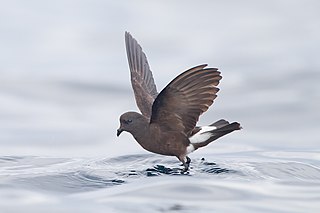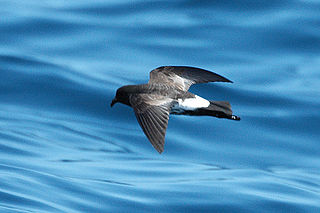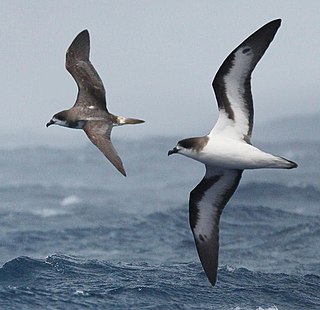Related Research Articles

Procellariiformes is an order of seabirds that comprises four families: the albatrosses, petrels and shearwaters, and 2 families of storm petrels. Formerly called Tubinares and still called tubenoses in English, procellariiforms are often referred to collectively as the petrels, a term that has been applied to all members of the order, or more commonly all the families except the albatrosses. They are almost exclusively pelagic, and have a cosmopolitan distribution across the world's oceans, with the highest diversity being around New Zealand.

Northern storm petrels are seabirds in the family Hydrobatidae, part of the order Procellariiformes. The family was once lumped with the similar austral storm petrels in the combined storm petrels, but have been split, as they were not closely related. These smallest of seabirds feed on planktonic crustaceans and small fish picked from the surface, typically while hovering. Their flight is fluttering and sometimes bat-like.

Petrels are tube-nosed seabirds in the bird order Procellariiformes.

The family Procellariidae is a group of seabirds that comprises the fulmarine petrels, the gadfly petrels, the prions, and the shearwaters. This family is part of the bird order Procellariiformes, which also includes the albatrosses, the storm petrels, and the diving petrels.

The European storm petrel, British storm petrel, or just storm petrel is a seabird in the northern storm petrel family, Hydrobatidae. It is the only member of the genus Hydrobates. The small, square-tailed bird is entirely black except for a broad, white rump and a white band on the under wings, and it has a fluttering, bat-like flight. The large majority of the population breeds on islands off the coasts of Europe, with the greatest numbers in the Faroe Islands, United Kingdom, Ireland, and Iceland. The Mediterranean population is a separate subspecies, but is inseparable at sea from its Atlantic relatives; its strongholds are Filfla Island (Malta), Sicily, and the Balearic Islands.

Leach's storm petrel or Leach's petrel is a small seabird of the tubenose order. It is named after the British zoologist William Elford Leach. The scientific name is derived from Ancient Greek. Oceanodroma is from okeanos, "ocean" and dromos, "runner", and leucorhoa is from leukos, "white" and orrhos, "rump".

Swinhoe's storm petrel or Swinhoe's petrel is a small, all-brown seabird of the storm petrel family Hydrobatidae.

Wilson's storm petrel, also known as Wilson's petrel, is a small seabird of the austral storm petrel family Oceanitidae. It is one of the most abundant bird species in the world and has a circumpolar distribution mainly in the seas of the southern hemisphere but extending northwards during the summer of the northern hemisphere. The world population has been estimated to be more than 50 million pairs. The name commemorates the Scottish-American ornithologist Alexander Wilson. The genus name Oceanites refers to the mythical Oceanids, the three thousand daughters of Tethys. The species name is from Latin oceanus, "ocean".

The white-faced storm petrel, also known as white-faced petrel is a small seabird of the austral storm petrel family Oceanitidae. It is the only member of the monotypic genus Pelagodroma.

The New Zealand storm petrel is a small seabird of the family Oceanitidae. Thought to be extinct since 1850, a series of sightings from 2003 to the present indicates the presence of a previously unknown colony. As of 2010, it is ranked on the IUCN Red List as critically endangered.

The band-rumped storm petrel, Madeiran storm petrel, or Harcourt's storm petrel is of the storm petrel family Hydrobatidae.

Mousa is a small island in Shetland, Scotland, uninhabited since the nineteenth century. The island is known for the Broch of Mousa, an Iron Age round tower, and is designated as a Special Protection Area for storm-petrel breeding colonies.

"The Song of the Stormy Petrel" is a short piece of revolutionary literature written by the Russian writer Maxim Gorky in 1901. The poem is written in a variation of unrhymed trochaic tetrameter with occasional Pyrrhic substitutions.

The Bermuda petrel is a gadfly petrel. Commonly known in Bermuda as the cahow, a name derived from its eerie cries, this nocturnal ground-nesting seabird is the national bird of Bermuda and can be found pictured on Bermudian currency. It is the second rarest seabird on the planet and a symbol of hope for nature conservation. They are known for their medium-sized body and long wings. The Bermuda petrel has a greyish-black crown and collar, dark grey upper-wings and tail, white upper-tail coverts and white under-wings edged with black, and the underparts are completely white.

Cook's petrel or the blue-footed petrel, is a Procellariform seabird. It is a member of the gadfly petrels and part of the subgroup known as Cookilaria petrels, which includes the very similar Stejneger's petrel.

The fork-tailed storm petrel is a small seabird of the storm petrel family Hydrobatidae. It is the second-most abundant and widespread storm petrel and is the only bird in its family that is bluish-grey in colour.

Markham's storm petrel is a species of storm petrel in the family Hydrobatidae. An all black to sooty brown seabird, Markham's storm petrel is difficult to differentiate from the black petrel Procellaria parkinsoni in life, and was once described as conspecific with, or biologically identical to, Tristram's storm petrel Oceanodroma tristrami. Markham's storm petrel inhabits open seas in the Pacific Ocean around Peru, Chile, and Ecuador, but only nests in northern Chile and Peru, with ninety-five percent of all known breeding populations in 2019 found in the Atacama Desert. First described by British ornithologist Osbert Salvin in 1883, the bird was named in honor of Albert Hastings Markham, a naval officer who collected a specimen off Peru.

Austral storm petrels, or southern storm petrels, are seabirds in the family Oceanitidae, part of the order Procellariiformes. These smallest of seabirds feed on planktonic crustaceans and small fish picked from the surface, typically while hovering. Their flight is fluttering and sometimes bat-like.

Hydrobatinae is one of two subfamilies of storm petrels. The distribution of the subfamily is predominantly in the northern hemisphere. The subfamily contains two genera in which there are 18 species. They were the first group of storm petrels to break off from the ancestral petrel stock, and for this reason some authors have suggested that they should constitute a separate family from the Oceanitinae storm petrels.

Storm petrel may refer to one of two bird families, both in the order Procellariiformes, once treated as the same family.
References
- ↑ Merino, Santiago; Mínguez, Eduardo; Belliure, Belén (1999). "Ectoparasite effects on nestling European Storm-Petrels". Waterbirds. 22 (2): 297–301. doi:10.2307/1522219. JSTOR 1522219.